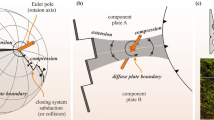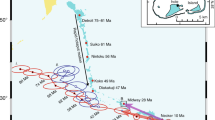Abstract
The absolute motion of the Bouvet triple junction has an important role in its mechanical evolution. At present, the relative velocity vectors of the South American, African and Antarctic plates form an obtuse isosceles triangle, and both the ridge–ridge–ridge (RRR) and ridge–transform–transform (RFF) configurations of the Bouvet are potentially stable. Sclater1 demonstrated that the Bouvet twice alternated between RRR and RFF in the past 20 Myr. The reasons for these changes are unclear, but the analysis of the absolute velocities of the two configurations presented here provides some insight; The motion of the RRR configuration of the Bouvet, with respect to a hotspot reference frame, carries the junction to the north-west (343°) at 14.7 km Myr−1, whereas the RFF form moves to the south-east (157°) at only 5.8 km Myr−1. The RFF configuration is stable only when the relative velocity triangle is precisely isosceles. As the RFF junction migrates away from the isosceles line, it becomes increasingly unstable, until it is forced to switch to RRR. The RRR junction then drifts back to the isosceles line where it reverts to RFF.
This is a preview of subscription content, access via your institution
Access options
Subscribe to this journal
Receive 51 print issues and online access
$199.00 per year
only $3.90 per issue
Buy this article
- Purchase on Springer Link
- Instant access to full article PDF
Prices may be subject to local taxes which are calculated during checkout
Similar content being viewed by others
References
Sclater, J. G. et al. J. geophys. Res. 81, 1857–1869 (1976).
McKenzie, D. P. & Morgan, J. Nature 224, 125–133 (1969).
McKenzie, D. P. & Parker, R. L. Earth planet. Sci. Lett. 22, 285–293 (1974).
Minster, J. B. & Jordan, T. H. J. geophys. Res. 83, B11 5331–5354 (1978).
Author information
Authors and Affiliations
Rights and permissions
About this article
Cite this article
Apotria, T., Gray, N. Absolute motion and evolution of the Bouvet triple junction. Nature 316, 623–625 (1985). https://doi.org/10.1038/316623a0
Received:
Accepted:
Published:
Issue Date:
DOI: https://doi.org/10.1038/316623a0
Comments
By submitting a comment you agree to abide by our Terms and Community Guidelines. If you find something abusive or that does not comply with our terms or guidelines please flag it as inappropriate.



